American Indians 美国印第安人
美洲印第安人的历史及文化

美洲印第安人的历史及文化美洲印第安人是美洲原住民的统称,有着悠久的历史和丰富的文化。
在前哥伦布时代,印第安人在美洲大陆上形成了多种独特的文明,其中最出名的当属玛雅文明和阿兹特克文明。
然而,这些文明随着欧洲殖民者的到来而逐渐消亡,印第安人经历了一段痛苦的历史。
本文将介绍美洲印第安人的历史及文化。
一、前哥伦布时代的印第安人在前哥伦布时代,美洲大陆上居住着大量的印第安人部落。
他们生活在不同的环境中,拥有着各自独特的文化和生活方式。
其中,玛雅文明和阿兹特克文明是最为出名的两个文明。
玛雅文明起源于公元前2000年左右,发展至公元16世纪初被西班牙人征服前。
他们建造了富丽堂皇的城市和宏伟的金字塔,崇拜太阳、月亮和星辰,发展出了复杂的日历和文字。
阿兹特克文明则起源于公元14世纪,建立在墨西哥高原上,曾经统治着广袤的领土,并建造了卓越的建筑和灌溉工程。
他们崇拜太阳神和战神,曾经展开过远征和征服。
除了这两个文明,其他地区的印第安人部落也在自己的领域内发展出了自己的文化和风俗。
例如,北美平原印第安人是以狩猎为生的游牧民族,他们打猎、捕鱼、采集和种植作为自己的主要生计,同时也发展了丰富的舞蹈、歌曲和神话传说。
南美洲的印第安人则主要是建立在一个农业社会的基础上,他们使用复杂的灌溉系统种植玉米、豆类和甜菜,制造出了各种精美的陶器和手工艺品。
二、西班牙殖民带来的改变哥伦布到达美洲大陆后,西班牙殖民者迅速占领了大片土地,并向印第安人强行推行自己的文化和信仰。
他们将印第安人视为原始野蛮人,进行了大规模的屠杀和奴役,剥夺了印第安人的权利和财产。
印第安人失去了原有的土地和文化,许多部落被迫灭亡或迁徙至其他地方。
同时,西班牙殖民者还带来了病毒和疾病等,导致许多印第安人死亡。
在西班牙殖民的影响下,印第安人的文化也开始发生了改变。
他们被迫接受基督教信仰,并逐渐放弃了原有的宗教和习俗。
西班牙殖民者还向印第安人传播了西式的饮食和服装,甚至将印第安人的语言和文字禁止使用。
英语国家社会与文化(美1)
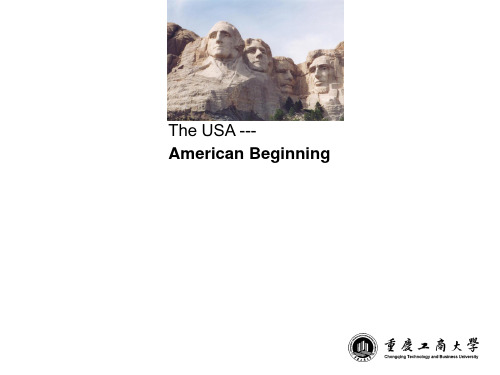
n. n. n. v. n.
遗产,传统 封建主,勋爵,贵族 庄园 熔化 商人
migration
militia mission mobility
n.
n. n. n.
迁移
民兵 使命 流动
mode
Montreal moral moralism naturalization nobility oath observe Old World
The USA --American Beginning
Preface
Hello Class! In today's class we are going to deal with the first chapter on the history of the United States of America. As is known to all, America is a new nation and the product of the Western civilization. In fact, the American continent was first discovered by an Italian sailor called Christopher Columbus in 1492. And the United States was not officially founded until 1776 when 13 former British colonies rose up against the British Empire and fought a war for their independence. But, before we start, let's take the time to preview some of the questions regarding the history of the United States. Please see if you can answer the following questions. Please supply the correct answers, if you happen to know them, in the space bellow.
北美印第安人的历史

北美印第安人的历史北美印第安人的历史可以追溯到数千年前。
在这片广袤的大陆上,印第安人部落繁多,他们拥有丰富的文化、传统和生活方式。
本文将带您走进北美印第安人的历史长河,了解他们的起源、社会结构、文化遗产以及与欧洲殖民者之间的互动。
一、起源与迁徙北美印第安人的起源可以追溯到约1.5万年前的旧石器时代。
根据考古证据,他们通过百万年的迁徙从亚洲穿越白令海峡抵达北美。
这段迁徙的历史也被称为“印第安人大迁徙”。
据研究,印第安人通过陆桥或船只跨越亚洲和北美之间的陆地和水域。
他们逐渐分化为不同的部落,并在北美大陆上形成了多样化的文化与社会结构。
二、社会结构与生活方式北美印第安人的社会结构多种多样,部落之间存在着一定程度的差异。
然而,广义上可以将其划分为狩猎采集部落、农耕社会以及游牧民族。
狩猎采集部落主要依靠狩猎、捕鱼和采集自然资源为生。
他们居住在草原、森林等适宜狩猎和采集的地区,并享有丰富的食物资源。
农耕社会主要以种植农作物为主要生计,如玉米、豆类和烟草等。
这些农耕文明在河流流域、山区以及适宜农作物种植的环境中繁荣发展。
游牧民族则以放牧为主要方式,他们经常迁徙和跟随动物迁徙,以获取牧场资源。
他们往往居住在大平原地区。
三、文化遗产北美印第安人丰富的文化遗产至今仍为人们所称道。
他们创造了独特的艺术形式、宗教仪式和传统习俗。
艺术形式方面,印第安人以绘画、雕刻、编织等艺术形式展示了他们对自然界万物的崇敬和理解。
他们用鲜艳的颜料和精细的手工制作出独特的艺术品和工艺品,如图腾柱、珠宝、陶器等。
宗教仪式是印第安人文化中极为重要的一部分。
他们崇拜大自然和祖先,通过祭祀、舞蹈和宗教仪式来表达对神秘力量的敬畏与感恩。
传统习俗则贯穿于印第安人的生活始终。
例如,部落之间的联姻、成人礼和战争仪式等都展示了他们的团结、自豪和传统价值观。
四、与欧洲殖民者的互动1492年,哥伦布发现了新大陆,并为之后的欧洲殖民者开启了北美大陆的探索。
随着欧洲殖民者的到来,北美印第安人逐渐与外界接触,并发生了翻天覆地的变化。
美国印第安人文化的多样性与特点

美国印第安人文化的多样性与特点美国印第安人(Native Americans)是美洲原住民的后裔,他们在美洲大陆上已有数千年的历史。
他们以独特的语言、文化和艺术形式闻名于世。
本文将探讨美国印第安人文化的多样性与特点,介绍其语言、宗教、艺术和传统习俗等方面。
一、语言多样性美国印第安人涵盖了众多部落和民族,因此他们拥有丰富多样的语言。
据统计,美国境内至少有300多种不同的印第安语言存在,其中很多正在濒临灭绝。
这些语言反映了不同部落的文化、历史和环境,是印第安人文化的重要组成部分。
例如,纳瓦霍语(Navajo)是美国境内使用人数最多的印第安语言,被纳瓦霍族人广泛使用。
此外,切罗基语(Cherokee)和苏语(Sauk)等也是一些重要的印第安语言。
这些语言的丰富性和多样性反映了美国印第安人的多样文化背景。
二、宗教与信仰美国印第安人的宗教和信仰体系因部落和地区的不同而有所差异。
然而,他们普遍相信与自然界和谐相处的重要性。
印第安人崇拜大地、天空、山川河流等大自然元素,并将其视为神圣。
这种信仰体系反映在他们的宗教仪式、祭祀和神话传说中。
例如,石头仪式是一种被多个印第安部落广泛采用的仪式,用于祈求土地的丰收和健康。
另外,很多部落都有神圣之物的概念,如神灵图腾(Spirit Totems)或神圣的草药,被视为保护者和指导者。
三、艺术形式美国印第安人以其独特的艺术形式而闻名于世。
他们以自然界中的形象和符号来创作艺术品,如织物、陶器、篮子等。
这些艺术品往往展现了他们的文化、宗教和历史。
例如,纳瓦霍族人以纺织品的制作而著名。
他们使用传统的纺车和手织工艺,将图案和符号编织到毯子和地毯中。
这些纺织品反映了纳瓦霍人的历史、宗教和象征意义。
此外,美洲原住民的雕塑艺术在世界范围内也享有盛名。
他们通过精湛的雕刻技术,创作出石雕、木雕和骨雕等艺术品。
这些作品常常表达了对自然界和宇宙的崇拜,体现了他们的智慧和创造力。
四、传统习俗美国印第安人的传统习俗是他们文化的重要组成部分。
高二英语英语国家历史与文化背景介绍练习题50题
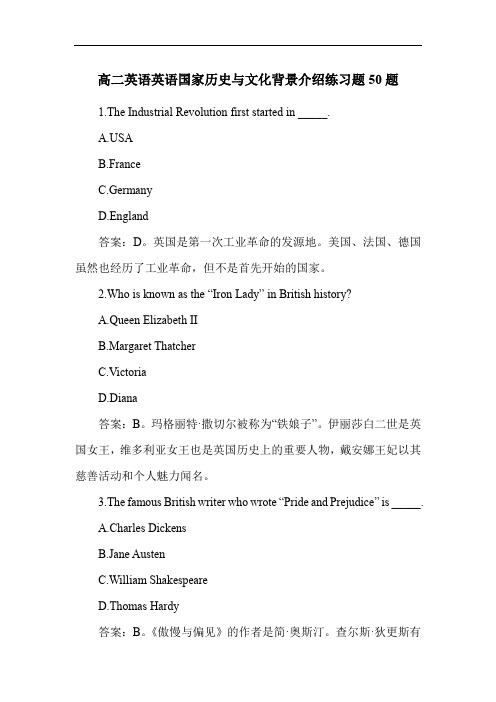
高二英语英语国家历史与文化背景介绍练习题50题1.The Industrial Revolution first started in _____.AB.FranceC.GermanyD.England答案:D。
英国是第一次工业革命的发源地。
美国、法国、德国虽然也经历了工业革命,但不是首先开始的国家。
2.Who is known as the “Iron Lady” in British history?A.Queen Elizabeth IIB.Margaret ThatcherC.VictoriaD.Diana答案:B。
玛格丽特·撒切尔被称为“铁娘子”。
伊丽莎白二世是英国女王,维多利亚女王也是英国历史上的重要人物,戴安娜王妃以其慈善活动和个人魅力闻名。
3.The famous British writer who wrote “Pride and Prejudice” is _____.A.Charles DickensB.Jane AustenC.William ShakespeareD.Thomas Hardy答案:B。
《傲慢与偏见》的作者是简·奥斯汀。
查尔斯·狄更斯有很多著名作品如《《双城记》等,威廉·莎士比亚的作品有《《哈姆雷特》等,托马斯·哈代的作品有《德伯家的苔丝》等。
4.The British national flag is known as _____.A.TricolorB.Star-Spangled BannerC.Union JackD.Maple Leaf答案:C。
英国国旗是米字旗,即Union Jack。
Tricolor 是法国国旗等三色旗的统称,Star-Spangled Banner 是美国国旗,Maple Leaf 是加拿大国旗的标志枫叶。
5.The Battle of Hastings in 1066 led to the Norman Conquest of _____.A.EnglandB.ScotlandC.WalesD.Ireland答案:A。
印第安人名词解释
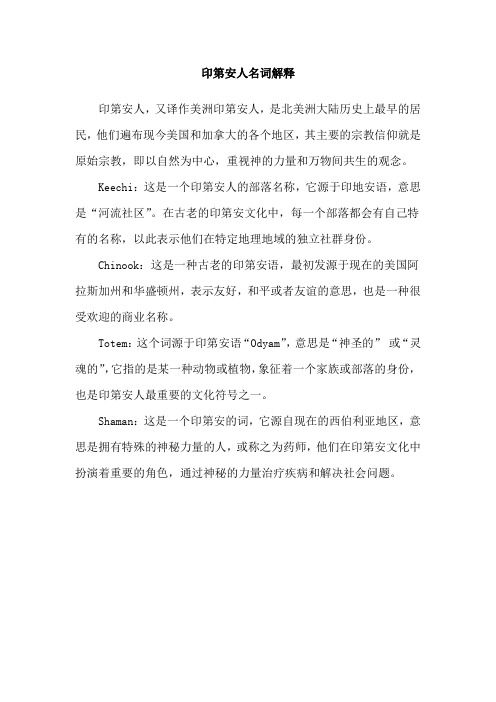
印第安人名词解释
印第安人,又译作美洲印第安人,是北美洲大陆历史上最早的居民,他们遍布现今美国和加拿大的各个地区,其主要的宗教信仰就是原始宗教,即以自然为中心,重视神的力量和万物间共生的观念。
Keechi:这是一个印第安人的部落名称,它源于印地安语,意思是“河流社区”。
在古老的印第安文化中,每一个部落都会有自己特有的名称,以此表示他们在特定地理地域的独立社群身份。
Chinook:这是一种古老的印第安语,最初发源于现在的美国阿拉斯加州和华盛顿州,表示友好,和平或者友谊的意思,也是一种很受欢迎的商业名称。
Totem:这个词源于印第安语“Odyam”,意思是“神圣的”或“灵魂的”,它指的是某一种动物或植物,象征着一个家族或部落的身份,也是印第安人最重要的文化符号之一。
Shaman:这是一个印第安的词,它源自现在的西伯利亚地区,意思是拥有特殊的神秘力量的人,或称之为药师,他们在印第安文化中扮演着重要的角色,通过神秘的力量治疗疾病和解决社会问题。
北美印第安人的历史遭遇与探究

北美印第安人的历史遭遇与探究北美印第安人是指在哥伦布到达美洲前后,生活在现今北美洲上的各个原住民族,如丰富多彩的印第安文化。
他们是北美洲最早的居民,生活在这片土地上已经有上万年的历史。
然而,与他们悠久的历史相比,他们所受到的遭遇却是残酷的。
本文将探究北美印第安人的历史背景、文化传承、遭遇以及当今状况。
一、北美印第安人的历史背景早在史前时期,北美洲上已有人类活动的痕迹。
从公元前10000年左右,印第安人就开始在太平洋沿岸的地区狩猎和采集。
公元一千年左右,一些热带地区的印第安人开始种植蔬菜、粮食。
14世纪以后,印第安文化在北美洲迅速发展壮大,出现了一些有较高文化水准的玛雅文化、阿兹特克文化、因卡文化、霍普韦尔文化等文化。
这些文化表现在艺术、制度、宗教等方面皆颇有代表性,是世界文化的瑰宝之一。
然而,随着欧洲人在15世纪开始向美洲进发,北美印第安人的历史遭遇开始发生巨大的变化。
二、北美印第安人的文化传承北美印第安人是一个富有传奇色彩的民族。
他们有独特的文化习俗和精美的艺术作品。
在文艺方面,美国印第安人的竹编、彩绘和壁画等作品都是具有浓郁印第安文化特色的。
此外,印第安人还有多种多样的音乐和舞蹈。
印第安舞蹈一般以仪式为核心,旨在表现给神灵和人类带来好运和幸福的愿望。
在宗教方面,很多印第安人信奉自己的神灵,认为神灵掌控着人类的命运。
许多印第安人将信仰视为其文化的核心,并坚定的维护着自己的信仰。
三、北美印第安人的遭遇自欧洲殖民者到达北美之后,印第安人的遭遇就开始了。
欧洲人带来了黑死病等病毒,导致北美各地的印第安人人口数量大幅下降。
除此之外,欧洲人还占据了印第安人的土地和资源,运用强大的军事力量迫使印第安人签下了不公平的条约,抹杀了他们的文化和传统。
在移民和西进的早期,美国政府甚至试图通过条约把印第安人吸收进自己的社会体系,结果导致更多的印第安人流离失所且生活贫困。
美国印第安人长期以来一直被过度剥削、歧视和社会忽视。
美国社会与文化名词解释
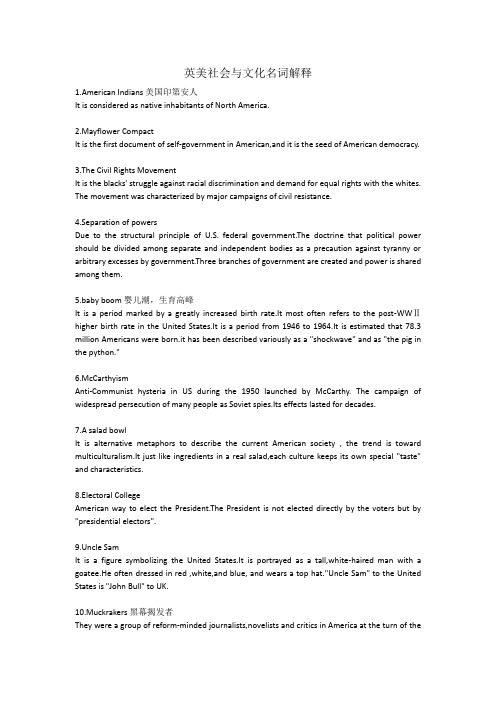
英美社会与文化名词解释1.American Indians美国印第安人It is considered as native inhabitants of North America.2.Mayflower CompactIt is the first document of self-government in American,and it is the seed of American democracy.3.The Civil Rights MovementIt is the blacks' struggle against racial discrimination and demand for equal rights with the whites. The movement was characterized by major campaigns of civil resistance.4.Separation of powersDue to the structural principle of U.S. federal government.The doctrine that political power should be divided among separate and independent bodies as a precaution against tyranny or arbitrary excesses by government.Three branches of government are created and power is shared among them.5.baby boom婴儿潮,生育高峰It is a period marked by a greatly increased birth rate.It most often refers to the post-WWⅡhigher birth rate in the United States.It is a period from 1946 to 1964.It is estimated that 78.3 million Americans were born.it has been described variously as a "shockwave" and as "the pig in the python."6.McCarthyismAnti-Communist hysteria in US during the 1950 launched by McCarthy. The campaign of widespread persecution of many people as Soviet spies.Its effects lasted for decades.7.A salad bowlIt is alternative metaphors to describe the current American society , the trend is toward multiculturalism.It just like ingredients in a real salad,each culture keeps its own special "taste" and characteristics.8.Electoral CollegeAmerican way to elect the President.The President is not elected directly by the voters but by "presidential electors".9.Uncle SamIt is a figure symbolizing the United States.It is portrayed as a tall,white-haired man with a goatee.He often dressed in red ,white,and blue, and wears a top hat."Uncle Sam" to the United States is "John Bull" to UK.10.Muckrakers黑幕揭发者They were a group of reform-minded journalists,novelists and critics in America at the turn of the20th century.They exposed various dark sides of the seemingly prosperous society.They gave rise to the Progressive movement.11.Rosa Parks IncidentRosa Parks is a middle-aged black woman.She refused to give up her seat on the bus to a white passenger who had just gotten on.Then Rosa was arrested and fined 10 dollars.This insident led to a 1956 Supreme Court decision banning segregated buses.12.A nation of nations万民之邦The US has long been known as a nation of immigration,a multinational and multiracial country.The vast majority of its population is immigrants or descendants of immigrants coming from all over the world.13.New EnglandIn 1620,pilgrims from England first settled in New England to form plymouth Colony.But now,it is a region in the northeastern comer of the United States consisting of the 6 states.14.WASPsIt refers to the White Anglo-Saxon Protestants and their descendants.They are Americans of English ancestry.Until quite recently,to many peopie the WASPs had been the Americans.Their culture had represented the American culture.The WASPs still dominate every aspect of American life.。
第三章:第一节:美国印第安人

(二)最新种族人口构成:
白人、黑人、印地安人、各种混血种人、各少数族 裔等 2005年7月至2006年7月,少数族裔人口由9830万增 加到1.007亿,即如今3个美国人当中就有一个是 少数族裔。在此期间,拉美裔、亚裔和黑人的人口 分别增长了3.4%、3.2%和1.3%,而作为 主体族群的非拉美裔白人只增长了0.3%。
1934年,国会制订《印第安人改组法》,承认土 著文化的价值,恢复部落制,帮助印第安人重建 部落政府。 1975年,国会通过《印第安人自决和教育援助法 》,宣布在保持联邦与部落特殊关系的前提下, 赋予部落政府参与联邦涉及印第安人的政策的制 订和执行。至此,文化多元主义最终取代种族同 化而成为美国政府印第安人政策的精神原则,部 落的合法地位获得可靠的保障。
丧葬习俗和死亡观念:
畸形为美的风俗
男尊女卑
印第安人的语言是世界上最 有趣、最难懂的语言之一
二、欧洲殖民者的入侵及印、白文化的接触
欧洲殖民者的入侵时白人的社会文化发展状况: *工、商业的发展 *技术和器物上的先进 *制度和组织上的发达 *以征服自然增殖财富为目标的人生观 白人移居北美,旨在寻求生存发展的空间和机遇, 他们与印第安人之间,便发生激烈的生存竞争,因 为两种生活方式根本就是水火不相容的。
3、土著习俗的变化 *放弃了赤身露体的习惯,衬衣、外套、裤子、裙子、 帽子、鞋子和袜子为他们所接受。 *男子蓄发涂面的风俗,也日益少见。 *驯养的牛、羊、猪肉代替了兽肉,面包、牛奶、咖啡 等食物饮料出现在他们的餐桌上。 *住进了固定的房舍 4、语言上的复杂多样性在不断消减 传统仪式、观念和习俗与现代物质、技术和制度因 素的混合,使土著社会失去整合,土著文化呈现支离 破碎和光怪陆离。
占据优势的白人文化,必然迫使土著文化为 其扩张让路,致使两种文化不能和平共存。 受性质和势能差异的制约,两种文化也不存 在彼此融合的可能。
印第安人属于哪种人种
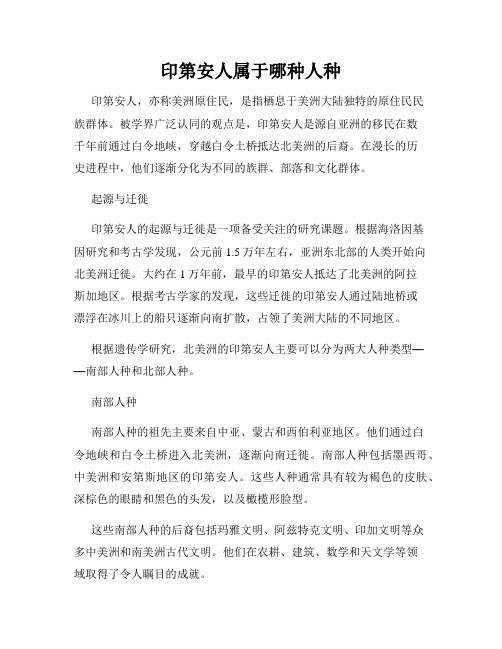
印第安人属于哪种人种印第安人,亦称美洲原住民,是指栖息于美洲大陆独特的原住民民族群体。
被学界广泛认同的观点是,印第安人是源自亚洲的移民在数千年前通过白令地峡,穿越白令土桥抵达北美洲的后裔。
在漫长的历史进程中,他们逐渐分化为不同的族群、部落和文化群体。
起源与迁徙印第安人的起源与迁徙是一项备受关注的研究课题。
根据海洛因基因研究和考古学发现,公元前1.5万年左右,亚洲东北部的人类开始向北美洲迁徙。
大约在1万年前,最早的印第安人抵达了北美洲的阿拉斯加地区。
根据考古学家的发现,这些迁徙的印第安人通过陆地桥或漂浮在冰川上的船只逐渐向南扩散,占领了美洲大陆的不同地区。
根据遗传学研究,北美洲的印第安人主要可以分为两大人种类型——南部人种和北部人种。
南部人种南部人种的祖先主要来自中亚、蒙古和西伯利亚地区。
他们通过白令地峡和白令土桥进入北美洲,逐渐向南迁徙。
南部人种包括墨西哥、中美洲和安第斯地区的印第安人。
这些人种通常具有较为褐色的皮肤、深棕色的眼睛和黑色的头发,以及橄榄形脸型。
这些南部人种的后裔包括玛雅文明、阿兹特克文明、印加文明等众多中美洲和南美洲古代文明。
他们在农耕、建筑、数学和天文学等领域取得了令人瞩目的成就。
北部人种北部人种的祖先主要来自东北亚一带,如现代的西伯利亚和蒙古地区。
他们通过白令地峡进入北美洲,逐渐向南扩散,形成了北美洲原住民的多样性。
北部人种的特征包括较淡的皮肤颜色、深色的眼睛和黑色的头发,以及更加方形的脸型。
北部人种主要分布在北美洲地区,包括美国、加拿大、阿拉斯加等地。
这些人种后裔包括苏族、克里族、纳瓦霍族等众多部落和族群。
北部人种在生存环境严酷的北美洲大陆上发展出了独特的文化和生活方式,如狩猎、捕鱼、採集等。
多样性与文化印第安人的人种分布和文化多样性令人叹为观止。
无论是南部人种还是北部人种,每个族群都有自己的语言、传统、信仰和艺术形式。
这些文化遗产见证了印第安人在美洲大陆上长期生存和繁衍的历史。
印第安人是什么人种-人物特点习俗文化及分布范围

印第安人是什么人种-人物特点&习俗文化及分布范围印第安人崇奉万物有灵的图腾信仰,各部落每年都要举行各种图腾崇拜的宗教仪式,一些仪式流传演化下来就成为至今魅力犹存的非常独特奇异的节日。
以下是小编整理的印第安人是什么人种问题答案、人物特点、习俗文化及分布范围,欢迎阅读参考!印第安人是什么人种-人物特点&习俗文化及分布范围印第安人是什么人种黄色人种,也称“蒙古人种”,它具有下列特征:皮肤略带黄色或浅棕色,头发黑而平顺,颧骨突出,具有蒙古式的上眼皮皱纹。
黄色人种有两个支系:亚洲支系和美洲支系。
亚洲支系主要分布在亚洲的中部,东部和东北部地区。
在亚洲支系中分布在不同地区的人种差异也很大,亚洲北部或西伯利亚的蒙古人种身材更低些,面颊宽;亚洲东部地区的人身材高些;而亚洲东北部的士著民族如爱斯基摩人鼻孔很狭窄。
美洲支系主要指北美和南美大陆原有的居民如印第安人。
他们是亚洲支系的人经过楚克奇海和阿拉斯加而迁至美洲定居的。
基本介绍印第安人(Indians),亦作Amerindian或Amerind,是对除因纽特人外的所有美洲原住民的总称。
美洲土著居民中的绝大多数为印第安人,分布于南北美洲各国,传统将其划归蒙古人种美洲支系。
印第安人所说的语言一般总称为印第安语,或者称为美洲原住民语言。
印第安人的族群及其语言的系属情况均十分复杂,至今没有公认的分类。
印第安人也分为很多种,玛雅人就是印第安人的一个种族。
名称由来印第安人在公元15世纪末之前本来并没有统一的称法。
公元1492年,意大利航海家C·哥伦布航行至美洲时,误以为所到之处为印度,因此将此地的土著居民称作“印度人”(西班牙语:“indios”)。
后人虽然发现了哥伦布的错误,但是原有称呼已经普及,所以英语和其他欧洲语言中称印地安人为“西印度人”,在必要时为了区别,称真正的印度人为“东印度人”。
汉语翻译时直接把“西印度人”这个单词翻译成“印第安人”或“印地安人”,免去了混淆的麻烦,到目前仍为最普及的用法。
印第安人

印第安人(Indians)亦作Amerindian或Amerind。
又称美洲原住民,是除爱斯基摩人外的所有美洲土著居民的总称。
印第安人即美洲土著居民。
此人种分布于南北美洲各国,属蒙古人种美洲支系。
使用印第安语,包括十几个语族,至今没有公认的语言分类。
印第安人是拉丁美洲的最早的居民。
他们之所以被成为“印第安人”,主要是因为当年哥伦布等探险者,以为他们到达的“新陆地”是印度,称当地居民为“印第安”人(“印度”一词的英文发音。
)印第安人以前曾称为红种人,因为他们的皮肤经常是红色的,后来才知道这些红色是由于习惯在面部涂红颜料所给人的错误认识。
研究者认为,印第安人的祖先大约是在2万年前从亚洲渡过白令海峡到达美洲的,或者是通过冰封的海峡陆桥过去的。
他们与亚洲同时代的人有某些相同的文化特色,例如用火、驯犬及某些特殊仪式与医疗方法等。
印第安人经过两万多年的文化,产生了许多不同的民族和语言,在历史上曾建立过四个帝国,最重要的是中美洲的阿滋特克帝国和南美洲的印加帝国,发明过玛雅文字,对天文学研究的造诣也相当深,为世界提供了玉米、番薯、西红柿、烟草、可可等作物。
由于殖民者迫害、杀戮印地安人,毁灭印地安文化,致使现在残存的古代文明材料已经不多,但目前的研究越来越引起考古界的关注,美洲国家也开始下大力发掘古代印地安文化。
印第安人分布北美洲西部、大平原和北美东部的古印第安人(Paleo-Indian),尽管环境不同,却有类似的经济活动。
在现在美国西部──从俄勒冈州到墨西哥北部,从太平洋海岸区到落矶山东边──散居著沙漠文化的印第安人,以狩猎及采集果实为生,但已有原始农业技术发展。
太古晚期在工具技术上有了进步的发展,诸如有沟槽的石斧及石锤等,而且在不同地理区域的部落间有贸易制度。
西元前3000∼前2000年,气候变得温暖,于是有些印第安人跟在吃草的野牛之后,进入萨斯喀彻温(Saskatchewan)河与亚伯达(Alberta)地区,亦有更北进入北极冻原。
indian是印度人还是印第安人
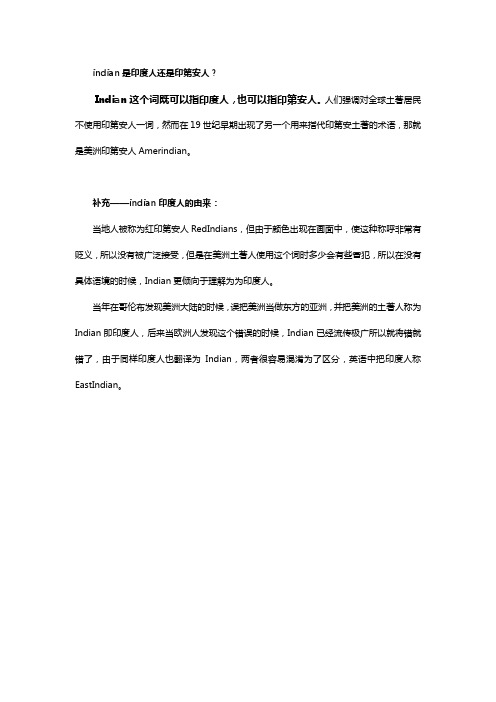
indian是印度人还是印第安人?
Indian这个词既可以指印度人,也可以指印第安人。
人们强调对全球土著居民不使用印第安人一词,然而在19世纪早期出现了另一个用来指代印第安土著的术语,那就是美洲印第安人Amerindian。
补充——indian印度人的由来:
当地人被称为红印第安人RedIndians,但由于颜色出现在画面中,使这种称呼非常有贬义,所以没有被广泛接受,但是在美洲土著人使用这个词时多少会有些冒犯,所以在没有具体语境的时候,Indian更倾向于理解为为印度人。
当年在哥伦布发现美洲大陆的时候,误把美洲当做东方的亚洲,并把美洲的土著人称为Indian即印度人,后来当欧洲人发现这个错误的时候,Indian已经流传极广所以就将错就错了,由于同样印度人也翻译为Indian,两者很容易混淆为了区分,英语中把印度人称EastIndian。
2023年宁夏回族自治区中考英语真题 (解析版)
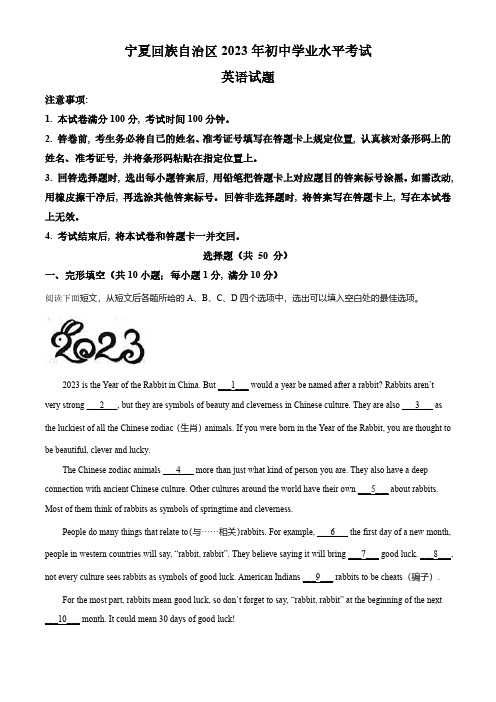
宁夏回族自治区2023年初中学业水平考试英语试题注意事项:1.本试卷满分100分,考试时间100分钟。
2.答卷前,考生务必将自己的姓名、准考证号填写在答题卡上规定位置,认真核对条形码上的姓名、准考证号,并将条形码粘贴在指定位置上。
3.回答选择题时,选出每小题答案后,用铅笔把答题卡上对应题目的答案标号涂黑。
如需改动,用橡皮擦干净后,再选涂其他答案标号。
回答非选择题时,将答案写在答题卡上,写在本试卷上无效。
4.考试结束后,将本试卷和答题卡一并交回。
选择题(共50分)一、完形填空(共10小题;每小题1分,满分10分)阅读下面短文,从短文后各题所给的A、B、C、D四个选项中,选出可以填入空白处的最佳选项。
2023is the Year of the Rabbit in China.But___1___would a year be named after a rabbit?Rabbits aren’t very strong___2___,but they are symbols of beauty and cleverness in Chinese culture.They are also___3___as the luckiest of all the Chinese zodiac(生肖)animals.If you were born in the Year of the Rabbit,you are thought to be beautiful,clever and lucky.The Chinese zodiac animals___4___more than just what kind of person you are.They also have a deep connection with ancient Chinese culture.Other cultures around the world have their own___5___about rabbits. Most of them think of rabbits as symbols of springtime and cleverness.People do many things that relate to(与……相关)rabbits.For example,___6___the first day of a new month, people in western countries will say,“rabbit,rabbit”.They believe saying it will bring___7___good luck.___8___, not every culture sees rabbits as symbols of good luck.American Indians___9___rabbits to be cheats(骗子).For the most part,rabbits mean good luck,so don’t forget to say,“rabbit,rabbit”at the beginning of the next ___10___month.It could mean30days of good luck!1.A.whenB.whyC.whereD.what2.A.playersB.actorsC.guidesD.animals3.A.trainedB.savedC.knownD.printed4.eB.welcomeC.stopD.tell5.A.ideasB.ordersC.examsD.chances6.A.withB.ofC.toD.on7.A.themB.herC.himD.me8.A.SuddenlyB.HoweverC.PolitelyD.Luckily9.A.considerB.helpC.wishD.teach10.A.famousB.strangeC.newD.safe【答案】1.B 2.D 3.C 4.D 5.A 6.D7.A8.B9.A10.C【解析】【导语】本文主要介绍了和兔子有关的文化。
论美国英语的特点

论美国英语的特点英语,是当前世界上通行最广的语言之一。
由于英语的使用范围极为广泛,所以不可避免地出现了各种地区性变体,除英国英语外,还有美国英语、加拿大英语、澳洲英语、新西兰英语、南非英语等,其中最值得注意的是美国英语。
美国是当今世界独一无二的超级大国,美国文化正在通过种种形式影响着世界各国,这些形式大都离不开美国英语。
对学习英语的中国人来说,学习并了解美国英语,可以更好地融入美国的氛围,无论是掌握商务用语、吃透生活用语、丰富娱乐生活还是从事影视剧本的写作,都要了解美国英语的特点。
美国英语也是英语,最早也来自英国,所以,在谈美国英语的特点时,其中有一部分是相对于英国英语来说的,因为美国英语源于英国英语,只是在不断地发展和变化中产生了属于美国的独特性。
简单地说,美国英语的特点可以分为三大类:一、美国英语的一致性、二、丰富多彩的美国英语词汇、三、美国英语的一些读写差异一、美国英语的一致性作为美国唯一的官方语言和多民族通用语言, 美国英语具有惊人的一致性。
早在17 世纪, 美国还处在殖民地初期, 就是如此。
美国的早期移民, 大多来自英国的中部、南部和伦敦地区; 在英国, 他们基本上属于同一社会阶层, 而且讲的是同一种语言。
这些人到了美国, 无论流动到何处, 从事何种职业, 他们坚持讲自己国家的语言。
他们在殖民地所处的社会地位或阶层常有变动, 居住的地点也不稳定, 经常从一个地区流动到另一个地区。
可以说, 无论是在发音方面, 还是在用词方面, 美国英语都不太容易受到地方色彩的影响, 因而美国这块土地上的人所讲的英语克服了空间上的障碍, 有着惊人的一致性, 与印度、前苏联、中国等国家同时并存多种民族语言或方言的情况形成鲜明的对比。
美国英语的一致性是美国人民生活进步与社会发展的产物。
后来, 陆续进入美国的新移民急于挤进已经讲着英语的高级社会阶层, 这种心情激励他们学习使用社会通用的语言。
曾经来自不同国家和地区的民族集团, 生活在同一社会, 互相接触、影响和融合, 共同创造和丰富了美国的语言与文化。
American Indians美国印第安人
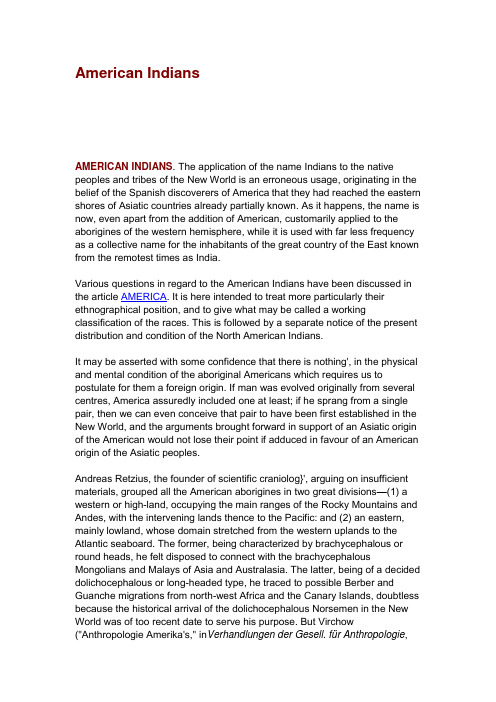
American IndiansAMERICAN INDIANS. The application of the name Indians to the native peoples and tribes of the New World is an erroneous usage, originating in the belief of the Spanish discoverers of America that they had reached the eastern shores of Asiatic countries already partially known. As it happens, the name is now, even apart from the addition of American, customarily applied to the aborigines of the western hemisphere, while it is used with far less frequency as a collective name for the inhabitants of the great country of the East known from the remotest times as India.Various questions in regard to the American Indians have been discussed in the article AMERICA. It is here intended to treat more particularly their ethnographical position, and to give what may be called a working classification of the races. This is followed by a separate notice of the present distribution and condition of the North American Indians.It may be asserted with some confidence that there is nothing', in the physical and mental condition of the aboriginal Americans which requires us to postulate for them a foreign origin. If man was evolved originally from several centres, America assuredly included one at least; if he sprang from a single pair, then we can even conceive that pair to have been first established in the New World, and the arguments brought forward in support of an Asiatic origin of the American would not lose their point if adduced in favour of an American origin of the Asiatic peoples.Andreas Retzius, the founder of scientific craniolog}', arguing on insufficient materials, grouped all the American aborigines in two great divisions—(1) a western or high-land, occupying the main ranges of the Rocky Mountains and Andes, with the intervening lands thence to the Pacific: and (2) an eastern, mainly lowland, whose domain stretched from the western uplands to the Atlantic seaboard. The former, being characterized by brachycephalous or round heads, he felt disposed to connect with the brachycephalous Mongolians and Malays of Asia and Australasia. The latter, being of a decided dolichocephalous or long-headed type, he traced to possible Berber and Guanche migrations from north-west Africa and the Canary Islands, doubtless because the historical arrival of the dolichocephalous Norsemen in the New World was of too recent date to serve his purpose. But Virchow ("Anthropologie Amerika's," in Verhandlungen der Gesell. für Anthropologie,1877, p. 144-56) has amply shown that this classification is unten-able, and it will be seen further on that there are long and round-headed types often intermingled in every part of the continent. Virchow himself, while denying the claim of the American race to be considered autochthonous, declines to commit himself as to the probable regions whence they may have reached their present habitat. The theory of an Asiatic immigration via Behring Strait has been somewhat revived since ethnologists have, so to say, rediscovered the lost Tchuktchis of the north-east coast, of Siberia through Nordenskjold's Swedish polar expedition of 1878-9. These Tchuktchis are supposed to form the connecting link between the races of the two worlds, and the supposition is strengthened by the invention of an American branch of the tribe. Professor Nordenskjöld himself remarks that "this race, settled on the primeval route between the Old and the New World, bears an unmistakable stamp of tha Mongols of Asia and Eskimo and Indians of America"(Petermann's Mittheilungen, 1879,p. 330). But Lieutenant Palander of the same expedition says that " they undoubtedly descend from the Greenland Eskimo" (ib.), which would at once deprive them of all value as a connecting link, while Peschel (Races of Man, p. 391) much more probably allies them to the Itelmes (Kamtchadales), the two languages being "as closely related as is Spanish to Portuguese." W. H. Dall (Contributions to American Ethnology, vol.i., Washington, 1877) further points out that the Innuit (Eskimo) tongue, said to be spoken by the Tchuktchis, is merely a trading jargon, a mixture of Koriak, Tchuktchi, Innuit, English, Hawaiian, and others. It is also to be noted that the Samoyedes and other Asiatic Arctic peoples, assumed by many to be thepro-genitors of the Eskimo, are of Mongoloid stock and distinctly brachycephaltus, while the Eskimo are the most dolichocephalous race on the globe next to the Kai Colos of Fiji (Flower). Thus the Eskimo, instead of being a connecting link, form an anthropological barrier between the populations of the two hemispheres at the very point geographically most convenient for effecting the transition.Nor would the question be much furthered by allowing the arrival of a few barbarous tribes via Behring Strait in prehistoric times. Their presence would leave the Aztec, Mayan, Peruvian, and other local cultures unexplained, except as independent developments. And more recent historic migrations of Chinese, Japanese, and other civilized peoples, otherwise involved in tremendous difficulties, would leave equally unexplained the primevalmound-building races of the Ohio valley and the still more ancient Brazilian races of the Santa Catharina and Santos shell-heaps. Because a stray vessel has been cast ashore on the western seaboard since the discovery of America, Virchow suggests the possibility of similar arrivals in remoter times. But if the Chinese arrived so recently as even 8000 years ago (an extreme supposition) in sufficient numbers to build up a civilization in Central America, the Chinese origin of such a civilization would to this day be as self-evident as is theChinese origin of the neighbouring Japanese civilization. The foreign founders of these communities would necessarily have brought with them their arts, their domestic animals, their more useful plants and cereals, without which they must have themselves speedily perished or been absorbed in the surrounding native populations. But no trace of these things was found in the New World on its discovery. There was neither the rice of the Chinese, nor the wheat, barley, oats, or rye of the Western nations, nor the iron now proved to have been known to the ancient Assyrians and Egyptians, nor the horse, camel, ox, sheep, pig, dog, or poultry of the eastern hemisphere. Instead of these, there was little beyond one cereal (maize), one esculent root (potato), one feeble beast of burden (llama), limited to the uplands of the southern Cordilleras, one species of dog elsewhere unknown. Most of the useful plants and animals of the East have since been introduced, and flourish vigorously even in the wild state, a sufficient proof that they would have been propagated had they been introduced at an earlier epoch. The knowledge of metals was limited to copper, both wrought and, in Wisconsin, apparently cast (J. S. Butler), bronze, lead, gold, and silver. Otherwise most of the nations were at the discovery still in the Stone Age; and, although Virchow's assertion may be true that the most practised archaeologist will fail to detect any material difference between the stone implements of the two hemispheres, this merely implies that the arts of Palaeolithic and Neolithic man were pretty much the same every-where.Nor is there anything in the religions, systems of govern-ment, architecture, and other arts of the native Americans, by which they can be connected with the corresponding-systems of the East. That the Toltec builders of the low obtruncated Mexican pyramids were a different people from the pyramid builders of the Nile valley, and that the mummies of the Ancon necropolis and other parts of Peru were of a different stock from the Egyptian mummies, is sufficiently evident from the texture of the hair alone. The hair of the old cultured races of America was the same as that of all the later American races, uniformly lank, because cylindrical in section. The hair of the old Egyptians, like that of the modern Fellahin, is, on the contrary, uniformly wavy, because more or less oval in section. The religions, again, of the Red Man, we are told by Carl Schultz-Sellack, Oscar Loew, and other good observers, are " essentially astrological, based on star, sun, and moon worship," with which was often associated an intricate method of measuring time built on a series of twenty constellations " (Zeitschr. für Ethnologie, 1879, p. 209). "The sun," says Loew, "is the god of most Indian tribes. ' He diffuses warmth and nourishment for us and our animals ; why shall we not worship him ]' observed to me on one occasion Masa-yamtiba, a Moqui Indian (New Mexico) " (ib. p. 265). This Masayamtiba was a better philosopher than those ethnologists who seek for the origin of such a simple cult in the remote corners of the globe, rather than in the beneficial influence of the heavenly bodies which shine alike for allmankind. The four great gods of the Mayas, the "props of the heavens," answered to the four great Mexican gods of the four quarters of the compass, all being associated with the four elements of wind, water, fire, and earth. But to what does either system answer in the polytheistic creeds of the Hindus, Assyrians, Babylonians, or other nations of antiquity 1 There is something similar in the Neo-Buddhistic teachings; but Buddhism, even of the oldest type, is much too recent to explain anything in the religious worlds of Mexico or Yucatan. The hare is associated in America, in Asia, and even amongst the Bushmen of South Africa with the moon. But this association was obviously suggested independently by the spots which, especially in the first quarter of the moon seem to present the outlines of a hare on its form. Waitz (Anthropology, p. 255) well observes that a common belief in a universal flood, or in the periodical destruction of the world, whether by fire, water, storms, or earthquakes, and analogous or parallel lines of thought—taken individually—afford no proof whatever in favour of affinity, and even resemblances in several points possess only a secondary importance; for they may partly, under like conditions, arise spontaneously among peoples who have always lived in a state of separation, or may have partly resulted from periods of short intercourse between two different peoples.In any case, these slight coincidences are of little account when weighed against the argument based on diversity of speech. The tremendous force of this argument, as applied to the American aborigines, is scarcely realized by anthropologists such as Waitz or Virchow, who have not culti-vated philological studies, and it is significant that, in the already quoted paper by Virchow on the " Anthropology of America," the linguistic element is not even referred to. On the other hand, it has been greatly depreciated and even brought into contempt by the vagaries of certain etymologists, who discover affinities where there is nothing but the vaguest verbal resemblance. Science hasdemon-strated beyond all cavil that, while differing widely among themselves, the American languages not only betray no affinity to any other tongues, but belong to an absolutely distinct order of speech. They are neither isolating or mono-syllabic like the Indo-Chinese group, agglutinating like the Ural-Altaic, Bantu, or Dravidian, nor inflexional like the Semitic and Aryan. They come nearest in structure to the Basque, which is the only incorporating language of the Old World, but differ from it essentially inasmuch as their capacity of incorporating words in the sentence is not restricted to the verb and a few pronominal elements, but extends in principle to all the parts of speech. This faculty, which, with one or two doubtful exceptions, seems to be characteristic of every American idiom from Behring Strait to Cape Horn, has received the name of polysyn-thesis, literally "a much putting together." Hence, in a comprehensive classification of articulate speech aceording to its inner mechanism, a special place must be reserved for the American group; and, if we assume as the most probable theory that all speech has slowly evolvedfrom a few simple beginnings, passing successively from the state of crude roots to the isolating condition, and so onwards to the agglutinating and other orders, then in such a scheme the American will stand apart in some such position as under :—_Incorporation.Agglutination.Isolation.(Bantu, Berber, kc.) (Basque alune.)(Chinese, Anadíese, r¿ Siamese, &c.) %s\ •</mInflexion.Polysynthesis. (American alone.)Here it is not intended to imply that American derives from Malayan or Dravidian, but only from some now extinct agglutinating forms of speech of which Malayan or Dravidian maybe taken as still surviving typical instances. The disappearance in America of all such assumed forms, unless the Otomi of Mexico is to be accepted as a solitary lingering specimen, argues both a very great antiquity and an independent evolution of the American languages. And as the course this evolution has taken differs entirely from that pursued by the idioms of the _ Old World, it follows that the first peopling of America, if from the Old World, must be thrown back to a time when all speech itself was in its infancy, to a time when slow diffusion might be conceived as equally probable from an eastern or a western starting-point. It is this feature of polysynthesis that gives the American race its first and greatest claim to be regarded as truly autochthonous, in the same sense that we regard the Mongolian and Caucasian races as truly autochthonous in Asia.Sayce (Science of Language, 1880) has finally adopted this view.There is a general consensus amongst anthropologists that on the western continent we are in presence of two distinct original types, the brachycephalous and dolicho-cephalous. But these are no longer confined to separate geographical areas, as Betzius supposed. The very general practice of artificially flattening or otherwise deforming the skull has naturally caused less value to be attached to the craniological test in America than elsewhere. The practice has been traced back even to prehistoric times, and a clay figure recently found associated with the remains of a child by Reiss and Stübel in a grave in Ancon puts in a clear light the method adopted by the ancient Peruvians (The Necropolis of Ancon, Berlin and London, 1881, plate 90). Still, careful investigations have placed it beyond doubt that the normal skull both in North and in South America is now mesaticephalous, or of a type intermediate between the two extremes, a fact sup posed to imply a general intermingling of the two primeval stocks. On the other hand, Virchow (loc. cit., passim) showsperfectly normal ancient and recent crania from both sides of Greenland, from El Carmen on the Rio Negro, Patagonia, from the Botocudo tribe, East Brazil, from a tumulus of Santa Fé de Bogota, and even a Peruvian mummy exhumed at Pancatambo, all of which are distinctly, in some cases extremely, dolichocephalic. In the same way he produces brachycephalic skulls from the Brazilian shell-mounds of Santos and Santa Catharina, from the barrows of the Ohio valley mound-builders, from the Carib and Araucanian tribes, and from the Pampas of La Plata, the last mentioned of an extreme type, in close proximity to the extreme dolichocephalous specimens from Patagonia. Were it safe to argue from the analogy of Britain, where the dolichocephalic builders of the long barrows seem to have preceded and afterwards become intermingled with the brachycephalic builders of the round barrows (Dr Thurnam), the western continent might be supposed to have been successively occupied first by a long-headed and then by a round-headed race, which kept aloof in a few places, while more generally becoming fused in a normally mesaticephalic type. But we have in America no guide to the relative priority of the two forms of head, nor are there now any long-headed races on the eastern Asiatic seaboard whose ancestors might be taken as the precursors of the corresponding element in the West. The obvious alternative also remains, that the two forms may have become differentiated on the American continent, just as similar differentiations must, by those who do not accept the doctrine of fixity of species, be assumed to have taken place in Asia. For such an evolution America offered a more ample field even than Asia, for it is not confined to the northern hemisphere, but stretches from the Arctic nearly to the Antarctic Circle, presenting in this wide range almost every conceivable variety of climate, atmosphere, soil, and temperature.We thus see that the two cranial forms do not necessarily militate against the possible primordial unity of the homo Américaines. This unity seems on the other hand implied in certain physical and mental features, common to all the native races. Of the physical traits the most important and uniform are—(1) the hair, which is always black, coarse, glossy, and long, like a horse's mane, round in transverse section and persistent to extreme old age; (2) slight beard, but always straight, never wavy ; (3) eyes small, black, somewhat deep-set, always horizontal ; (4) eye-brows narrow, very arched, and black ; (5) prominent cheek bones and nose, the latter often very long and aquiline. other region of the globe where so great a variety of colour prevails. The more general tints are a copper or cinnamon brown, and olive yellow; but the subjoined table of tribes, grouped according to their colour, shows that the extremes of a deep brown almost approaching a true black, and of a light or fair hue almost approaching a true white, also occur, altogether independently of latitude, climate, or elevation of the land :—==TABLE ==Similar tables might easily be drawn up of stature, varying from the dwarfish Eskimo, Fuegian (mean 5 ft. 1 in.), and Peruvian (mean 4 ft. 9 in.) to the gigantic Patagonian, the tallest race on the globe.No less varied are the other physical traits, while the wide divergence of mental capacity is sufficiently indicated on the one hand by the Cherokees of the southern Alleghanies, who in 1824 invented a complete syllabic writing system, and who can reckon to a million and upwards, and on the other by the Chiquitos of the Bolivian lowlands, who, D'Orbigny assures us (op. cit. ii. p. 163), "cannot get beyond one (tama), after which they have nothing but terms of comparison." The only real intellectual faculty common to all the American races is that implied by the peculiar polysynthetic mechanism of their speech. But beneath this general morphological structure, the substance of the languages themselves varies greatly in all that concerns their phonetic systems, vocabularies, relational forms, syntax, and methods of combination. While, for instance, the Thlinkeet of the extreme north-west Pacific seaboard, the Apache of Arizona, the Quichua of Peru, and the Aymara of the Bolivian uplands are amongst the very harshest and most guttural tongues in the world, the Otuke of the Bolivian plains, the Mohave of Arizona, the Chiquito of the upper Paraguay basin, the Samucu on the north frontier of Gran Chaco, and many Amazonian dialects are distinguished by great softness, often rivalling in euphony the most musical languages of the eastern hemisphere. The linguistic families differ from each other, not only in the measure to which their polysynthesis has been developed, but even in its very character, so that while some have scarcely yet arrived at a clear differentiation of verb and noun, others, like the Iroquois, have a purely verbal, others again, such as the extinct Timucua of Florida, an exclusively nominal inflexion. In the same way some are partial to prefixes, some to suffixes, some to infixes. Many of the Californian idioms seem to be still verging on the agglutinating stage, while the just-mentioned Timucua, the Aztec, Choctaw, Shoshone, Cree, Matlalzinca, and others of the Anahuac table-land, have reached the very acme of polysynthesis, in which all the parts of the sentence often become by indefinite composition and syncope fused into one interminable "bunch-word " of from ten to fifteen syllables and upwards. As these languages also differ entirely in their vocabularies, often pos-sessing not a single root in common, it follows that they can be no more classed together than can for instance the various agglutinating tongues of the Caucasus or the Soudan.It thus appears hopeless to look for any unity of details in the mental and physical faculties of the American aborigines. What they have in common is reducible to one physical and one mental quality, the universal texture and black colour of the hair, and their polysynthetic speech. These two propertiespoint directly at primordial unity of origin; the endless varieties of detail argue a prodigious antiquity and an independent development of the race on the American continent. The variety renders the work of classification a labour of extreme difficulty and uncertainty. Amidst all these endless points ofdiver-gence, it seems impossible to find any common basis round which to group the various tribes and races, and the pro-blem becomes further complicated by the fact that, while many of these tribes differ in speech, though evidently of one racial stock, others belonging to the same linguistic connexion present the widest physical discrepancies. Thus the Chiquitos and the Moxos peoples of Bolivia, obviously of one ethnical type, speak several fundamentally distinct languages. The same is true of the Moqtii, Queres, Isletta, Tegua, Zuiii, and other New Mexican Pueblos, while the reverse phenomenon is presented by the Montagnais and Nasquapees of Labrador, both of whom speak closely related Cree dialects, yet differ so much in appearance that, "judging from their exterior, one would suppose them to belong to different families of the human race " (Hind's Labrador, i. p. 332). Within comparatively narrow areas occurs occasionally every conceivable element of confusion, as in California and the south-western States, occupied by the morally debased and physically degraded Pah-Utes, the tall and manly Mohaves, the ferocious Apaches, the mild and intellectual Indians of the New Mexican Pueblos, some fishers and hunters, some living on roots and berries, some skilled agriculturists, all speaking fundamentally distinct languages.It is evidently impossible in such a case to adhere throughout to any one method of classification, and the following tentative survey is consequently based partly on the linguistic and partly on the ethnical elements, but partly also on mere geographical grounds. Fortunately there are in all the divisions of the continent a few great families, occupying vast regions, in which the ethnical and linguistic elements largely coincide. Foremost amongst these are thesub-arctic races and the Athabascans, Algonquins, and Dakotas in the north, the Maya-Quiche in the centre, and in the south the Caribs, Quichua-Aymaras, and Guaranis. These eight stocks cover jointly an area of not less than 11 millions of square miles, with a total aboriginal population of about four millions. But the seven millions of pure and mixed Indians occupying the remainder of the land, 5 millions of square miles in extent, are divided into a multiplicity of tribes, whose racial and linguistic affinities present problems the solution of which must long tax the utmost ingenuity of science. The total number of distinct languages alone is estimated at about 760, of which 430 are in the north and 330 in the south. In the northern division Balbi reckons, exclusive of California, thirty-two stock languages, far too low an estimate, while Bivero and Tschudi consider that of the southern idioms as many as four-fifths are radically distinct. But all such calculations are mere vague guesses at the truth; and in the present state of our knowledge it is impossible to form an estimate of the actual number of languages still current in Gran Chaco, Chiquitos, theAmazon valley, Central America, Mexico, California, the Columbia basin, regions where an extraordinary complexity of speech prevails. Nevertheless language forms on the whole perhaps the most convenient basis of classification, and without its aid it would have been impossible to determine the affinities of many wide-spread races, such, for instance, as that of the Arizona Apaches with the Canadian Chippewyans, or on the other hand to separate nations apparently closely related, like the Iroquois from their Algonquin neighbours, or the Araucanians from the Peruvians. The true relations of many tribes are, on the other hand, still doubtful, because of uncertainty re-garding the languages they speak. Such are the Cheyennes, Blackfeet, and Arapahoes, classed by some with the Dakotas, by others more probably with the Algonquins. Such also are the so-called Dieguehos (Kizh, Netela, and Kechi) of South California, oscillating between the Shoshone (Snake) and Yuma connexions, and the Pawnees of Nebraska and Kansas grouped by Bancroft with the Shoshone, but by Morgan regarded as an independent race. So close is the physical resemblance in these and many other cases that the question must ultimately be decided by a more exhaustive study of their languages.The American races may be conveniently grouped under the following eighteen divisions:—I. Hyperborean Races. —This division may on the whole be regarded as possessing a certain ethnical, linguistic, and geographical nnity. Still the Aleutians differ so greatly in language, and in some respects in type, from the Eskimo proper that it seems desir-able to class them separately. The Eskimo (or "Innuits," as they call themselves) are thus distributed by Dall:—Kopagmut, mouth of the Mackenzie; Kangmaligmut, thence to Manning Point; Nuwukmut, about Point Barrow and Icy Cape; Kowagmut, east end of Hotham Inlet; Salawigmut, at Salawik river; Chuklukmut, Gulf of Anadyr, Asia, often confounded with the Tchuktchis, from whom they are entirely distinct;Okee-ogmut, the islands north of 63° N. lat.; Kikhtogamut, St Lawrence Island; Kaviagmut, between Kotzebue and Norton Sounds; Mahlemut, neck of Kadiak Peninsula ; Unaligmut, from Norton Sound to mouth of the Yukon ; Ekogmut, Yukon Delta; Magemut, from Y'ukon to Kuskokwim river; Kuskwogmut,Kus-kokwim Bay; Nushagagmut, Bristol Bay, west to Cape Newenham; Ogulmut, north side of Alaska peninsula; Kaniagmut, south side of Alaska peninsula and Kadiak Island; Chugachigmut, Prince William's Sound to Atna river; Ugalakmut, from Atna river to Mount St Elias.The last-named, the Ugalenzes of the Russians, call themselves Chilkhatmut, and are undoubtedly true Eskimo; although fre-quently confounded with the Thlinkeets, on whose domain they converge. The few Innuit tribes east of theMackenzie have not been classified, but two of them, the Netchillik and Uqulsiksillik, were met by Lieut. Schwatka in 1879, who received from them some particulars regarding the remains of the Franklin expedition.Of the Aleuts, whose collective name is "Ungungun," or "People," there are two divisions :—I. Unalashkans, who call themselves Kagataya Kung'n ("Men of the East"), occupying the extremity of the Alaska Peninsula, as far as 160° W., and the Una-lashka or Fox Islands. 2. Atkhas, occupying all the other Aleutian Islands.II. Thlinkeets.—These form a distinct ethnical and linguistic group, occupying a compact geographical area along the Pacific coast from about Mount St Elias to the Simpson river, and including Sitka and the other adjacent islands. They are often called " Koloshes," a term of doubtful origin, but the national name is "T'linket," "man," or "T'linketantukwan," "men belonging to all villages." The tribal divisions are :—Yakutat, between Mounts St Elias and Fairweather ; Chilkahtkwan, Chilkhaht river valley; Sitkakwan, Sitka Islands and part of Prince of Wales Islands; Stakhinkwan, lower course of Stikine river; Takukwan and Skatkwan, Taku Inlet, Alaska; Iludsunu, Hood's Bay and Huchinu Rapids: Iliknu and Tungass, about Simpson river.The Thlinkeet language seems to be completely isolated, showing nothing beyond the faintest verbal resemblance to the Aleut and more southern Hydah. It has a plural in k, and an instrumental form in tch or tsh, the combination of which produces a heaping up of final consonants, which none but the natives can pronounce. Thus ass, tree ; asstsli, by a tree : isk, trees ; assktsh, by trees. (See "Notes on the Sitkakwan Dialect," by J. Furnhelm, in Contributions to American Ethnology, vol. i.)III. Columbian Races.—The general grouping of these is purely geographical, the main divisions largely ethnical and linguistic ; the area, British Columbia, Queen Charlotte and Vancouver Islands, Washington, and Oregon. Here are five stock races speaking an immense number of dialects, which, owing to their extremely evanescent character, it is very difficult to classify. The Puget Sound district, in the north-west of Washington, is in this respect specially remarkable. But great light has recently been thrown on this Babel of tongues by the labours of G. Gibbs, published by Dall, in North American Ethnology, vol.i. p. 240. The five stock races with their chief tribal subdivisions are asfollows :—1. Ilydahs.—lha Kaigani of Prince of Wales Islands and north coast of Queen。
印第安人(美洲土著的统称)
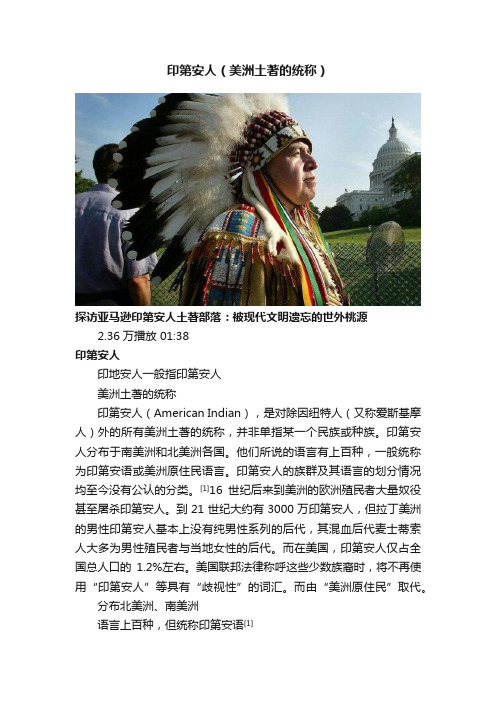
印第安人(美洲土著的统称)探访亚马逊印第安人土著部落:被现代文明遗忘的世外桃源2.36万播放 01:38印第安人印地安人一般指印第安人美洲土著的统称印第安人(American Indian),是对除因纽特人(又称爱斯基摩人)外的所有美洲土著的统称,并非单指某一个民族或种族。
印第安人分布于南美洲和北美洲各国。
他们所说的语言有上百种,一般统称为印第安语或美洲原住民语言。
印第安人的族群及其语言的划分情况均至今没有公认的分类。
[1]16世纪后来到美洲的欧洲殖民者大量奴役甚至屠杀印第安人。
到21世纪大约有3000万印第安人,但拉丁美洲的男性印第安人基本上没有纯男性系列的后代,其混血后代麦士蒂索人大多为男性殖民者与当地女性的后代。
而在美国,印第安人仅占全国总人口的1.2%左右。
美国联邦法律称呼这些少数族裔时,将不再使用“印第安人”等具有“歧视性”的词汇。
而由“美洲原住民”取代。
分布北美洲、南美洲语言上百种,但统称印第安语[1]代表玛雅人、阿兹特克人、印加人外文名American Indian中文名印第安人86%的人还看了•四大人种生殖差异•印第安摩托车价格表•印第安纹怎么才能消除•阿拉伯人简介4张印第安人“印第安人”这一称呼本是欧洲人对美洲土著的统称,后来通行于世界。
在南北美洲,有关中国古人东迁的线索不止邹衡遇到的一件。
譬如,维多利亚历史学会会长麦基威在其所写的《不列颠哥伦比亚掌故》一书中提到,加拿大西海岸夏洛特皇后海岛的土人,大多含有中国人的血统。
这些土人,自称是十三世纪元世祖忽必烈东征日本失败,漂流至该岛的元朝水师的后代。
譬如,委内瑞拉学者莫雷考证,在公元八世纪即中国唐代时,有一批居住在我国黑龙江、日本海和朝鲜之间的满族的祖先女真人,越过太平洋在中美洲登陆,被称为欧康人。
其中一部分移入墨西哥,一部分人进入南美洲各地,后与秘鲁的印加文化相融合。
还有从一些画报上看到中、南美洲丛林中的印第安人,你会以为他们是中国南方的少数民族,毫无疑问,大多数印第安人(包括爱斯基摩人)都具备黄种人的特点:头发色黑且直,黄皮肤、铲形门齿,以及白种人和黑色人种所不具备的婴儿出生时臀部的青色胎记。
北美印第安人的历史与文化

北美印第安人的历史与文化北美印第安人的历史与文化丰富多样,涵盖了数千年的漫长岁月。
这些原住民族群体在北美进行着独特的文化交流与发展,同时也面临着殖民者的入侵和压迫。
本文将探讨北美印第安人的历史与文化,带领读者了解他们的生活方式、宗教信仰、艺术表达以及社会结构等方面。
一、起源与迁徙北美印第安人最早出现于大约1.5万年前,据考古学家的研究,他们可能通过白令地峡谷和贝林海峡来自亚洲。
在此后的几千年间,印第安人逐渐分化形成了不同的种族和文化群体。
其中,南部诸族分布范围较广,而北部则主要是以伐木为主要生活方式的部落。
根据历史文献和口头传统,印第安人的祖先在历史上经历了多次大规模的迁徙。
这些迁徙可能源于资源的稀缺、气候变化或部族间的冲突等因素。
迁徙过程中,印第安人与当地环境相互适应,发展了各自的生活方式和文化传统。
二、生活方式北美印第安人的生活方式因地理环境、气候条件和资源丰度的不同而有所差异。
对于南部诸部落而言,农业是主要的生计来源,他们种植玉米、豆类和南瓜等作物,并以狩猎和捕鱼为辅。
他们建造了复杂的土地工程,如坎维斯(Kivas)和露天割礼场(Mound)等用于宗教和仪式之中。
相比之下,北部部落的生活方式更加游牧化,以狩猎和采集为主要生计。
他们经常追随野生动物的迁徙,居住在移动的帐篷或简易的结构中。
由于寒冷的气候,他们还制作了独特的皮革和皮毛服饰,以适应极端天气条件。
除了上述生活方式差异,印第安人还发展了特有的社会结构和政治制度。
有些部落采取了酋长制,由酋长来统治和决策,而另一些部落则采取了共同体制度,在部落成员间实行平等与合作。
三、宗教信仰宗教信仰在北美印第安人的文化中起着至关重要的作用。
他们通过祈祷、仪式、祭祀和故事传承等方式与神灵和自然界建立联系。
对于印第安人来说,大自然被视为一种有灵性的存在,他们相信地球、水、天空和动植物都有生命力。
印第安人的宗教信仰与他们的日常生活密不可分。
例如,南部的印第安部落会在丰收时举行仪式来感谢大地之母的恩赐。
- 1、下载文档前请自行甄别文档内容的完整性,平台不提供额外的编辑、内容补充、找答案等附加服务。
- 2、"仅部分预览"的文档,不可在线预览部分如存在完整性等问题,可反馈申请退款(可完整预览的文档不适用该条件!)。
- 3、如文档侵犯您的权益,请联系客服反馈,我们会尽快为您处理(人工客服工作时间:9:00-18:30)。
Company Logo
The Traditional culture of Oglala Lakota
Family is of utmost importance to the Oglala Lakota, with loyalty to the tribe coming in close second. Each family had one or more tipi households. The women were critical to the family's life: they made almost everything the family and tribe used.
Company Logo
Brief introduction
Company Logo
Brief introduction
Company Logo
Brief introduction Oglala flag
Company Logo
The history of Oglala Lakota
The Oglala Lakota, along with the six other groups of Lakota, had separated from each other by the early 19th century. By 1830, the Oglala had around 3,000 members. In the 1820s and 1830s, the Oglala, along with the Brulé another Lakota band, , and three other Sioux bands, formed the Sioux Alliance. This Alliance attacked surrounding tribes for territorial and hunting reasons.
My love is such that rivers cannot quench, 而我对你的 爱就是一把火,江河也不能熄灭 Nor ought but love from thee, give recompense. 世上没 有东西可与之相抵,除了你的爱 Thy love is such I can no way repay, 可是你的爱,如 此浓烈,我无以为报 The heavens reward thee manifold, I pray. 只求上苍给 你更多的恩赐 Then while we live, in love let’s so persevere 有生之年, 愿你我在爱中永存。
Company Logo
The bands
Each of the twenty tribes were subdivided into bands (tiyośpaye), which consisted of a number of smaller family camps (tiwahe). During parts of the year, the small camps were scattered across the region; at other times, these camps gathered together as a tiyośpaye to cooperate on activities such as a large buffalo hunt.
Company Logo
Notable Oglala
Company Logo
LOGO
To My Dear And Loving Husband 致我亲爱可爱的丈夫 ----Anne Bradstreet
If ever two were one, then surely we. 如果二即是一, 那么我们就是一个整体。 If ever man were loved by wife, then thee; 如果有谁深 受妻子爱戴,那么那人就是你。 If ever wife was happy in a man, 如果有谁因为自己的 男人而感到幸福, Compare with me, ye women, if you can. 那么来吧, 女人,与我相比,你是否幸福依旧。 I prize thy love more than whole mines of gold, 对我而 言你的爱远重金山, Or all the riches that the Earth doth hold. 比那东方的财 LOGO 宝还要耀眼
Notable Oglala
Company Logo
Brief introduction
The Oglala [oɡəˈlala] Lakota or Oglala Sioux [su:] (meaning ''to scatter one's own" in Lakota language[5]) is an American Indian tribe. A majority of the Oglala live on the Pine Ridge Indian Reservation in South Dakota ( 南达科他州松树岭印 第安保留地 ),the eighth-largest Native American reservation in the United States. The Oglala are a federally recognized tribe whose official title is the Oglala Sioux Tribe of the Pine Ridge Reservation.
海量PPT模板免费下载
Oglala Lakota
(沃格拉拉族 f introduction The history of Oglala Lakota The Traditional culture of Oglala Lakota
The bands
Beyond the family was the clan. Inheritance of clan chief positions and the composition of the clans was matrilineal: only the males born to the clan could be life chiefs of it. Within the clan, relatives whom Europeans and Americans would call cousins were considered, and identified by titles, equivalent to brothers and sisters. Because of the importance of the clan, a boy's maternal uncle, rather than his father.
LOGO
